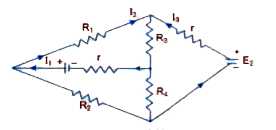Using the sine rule , prove the cosine rule.
To prove the cosine rule using the sine rule, we will follow a systematic approach.
1. State the Sine Rule:
The sine rule states that for a triangle with sides a,b,c opposite to angles A,B,C respectively:
asinA=bsinB=csinC=k
where k is a constant.
2. Express the Sides in Terms of the Sine Rule:
From the sine rule, we can express the sides a,b,c as:
a=ksinA,b=ksinB,c=ksinC
3. Write the Cosine Rule:
The cosine rule states:
c2=a2+b2−2abcosC
We need to prove this.
4. Substitute the Expressions for a,b,c:
Substitute a,b,c from step 2 into the cosine rule:
(ksinC)2=(ksinA)2+(ksinB)2−2(ksinA)(ksinB)cosC
5. Simplify the Equation:
Expanding both sides gives:
k2sin2C=k2sin2A+k2sin2B−2k2sinAsinBcosC
Dividing the entire equation by k2 (assuming k≠0):
sin2C=sin2A+sin2B−2sinAsinBcosC
6. Use the Sine Addition Formula:
Recall the sine addition formula:
sin2A+sin2B−2sinAsinBcosC=sin2C
This is a known identity, confirming that our expression holds true.
7. Conclusion:
Therefore, we have shown that:
c2=a2+b2−2abcosC
Hence, we have proved the cosine rule using the sine rule.
The sine rule states that for a triangle with sides a,b,c opposite to angles A,B,C respectively:
asinA=bsinB=csinC=k
where k is a constant.
From the sine rule, we can express the sides a,b,c as:
a=ksinA,b=ksinB,c=ksinC
The cosine rule states:
c2=a2+b2−2abcosC
We need to prove this.
Substitute a,b,c from step 2 into the cosine rule:
(ksinC)2=(ksinA)2+(ksinB)2−2(ksinA)(ksinB)cosC
Expanding both sides gives:
k2sin2C=k2sin2A+k2sin2B−2k2sinAsinBcosC
Dividing the entire equation by k2 (assuming k≠0):
sin2C=sin2A+sin2B−2sinAsinBcosC
Recall the sine addition formula:
sin2A+sin2B−2sinAsinBcosC=sin2C
This is a known identity, confirming that our expression holds true.
Therefore, we have shown that:
c2=a2+b2−2abcosC
Hence, we have proved the cosine rule using the sine rule.
Topper's Solved these Questions
- BOOK - NAVNEET PUBLICATION - MAHARASHTRA BOARDCHAPTER - TRIGONOMETRIC FUNCTIONS EXERCISE - Theory Questions1videos
TRIGONOMETRIC FUNCTIONS
- BOOK - NAVNEET PUBLICATION - MAHARASHTRA BOARDCHAPTER - TRIGONOMETRIC FUNCTIONS EXERCISE - Examples for Practise44videos
TRIGONOMETRIC FUNCTIONS
- BOOK - NAVNEET PUBLICATION - MAHARASHTRA BOARDCHAPTER - THREE DIMENSIONAL GEOMETRY EXERCISE - MULTIPLE CHOICE QUESTIONS8videos
THREE DIMENSIONAL GEOMETRY
- BOOK - NAVNEET PUBLICATION - MAHARASHTRA BOARDCHAPTER - VECTORSEXERCISE - Multiple choice question10videos
VECTORS
Similar Questions
BE and CF are two equal altitudes of a triangle ABC. Using RHS congruence rule, prove that the triangle ABC is isosceles.
 View Solution
View SolutionBE and CF are two equal altitudes of a triangle ABC. Using RHS congruence rule, prove that the triangle ABC is isosceles.
 View Solution
View SolutionSine formula proof :Sine Rule
View SolutionBE and CF are two equal altitudes of a triangle ABC. Using RHS congruence rule, prove that the triangle ABC is isosceles.
View SolutionIf A,BandC are the vetices of a triangle ABC, then prove sine rule asinA=bsinB=csinC.
View SolutionTheory OF Sine Rule || Cosine Rule || Projection formula
View SolutionState the two rules that serve as general rules for analysis of electrical circuits. Use these rules to write the three equations that may be used to obtain the values of the three unknown currents in the branches (shown) of the circuit
 View Solution
View SolutionFleming's left-hand rule is called as the motor rule and Fleming's right-hand rule is known as the generator rule.
View SolutionIllustrations Based upon Sine || Cosine Rule and Projection Formula
View SolutionBasic||Sine rule|| Cosine rule||Projection formula||Tangent rule || Napier Analogy
View Solution

